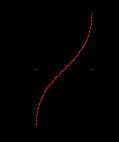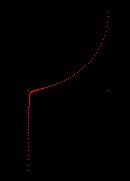 |
Lisp »Tips 'n Tricks
»Lisp & Array
»1
»2
»3
»4
»5
»6
»7
»8
»9
»10
Bézier definisce la curva P(u) in funzione della posizione di n+1 punti di controllo p.
P(u)=n∑i=0piBi,n(u)
Bi,n(u) è detta blending function
Bi,n(u)=C(n,i)ui(1-u)n-i
C(n,i) è il coefficiente binomiale
C(n,i)=n!/(i!(n-1)!)
Le Bi,n(u) costituiscono la chiave del comportamento delle curve di Bézier.
Le funzioni di miscelamento blending function possiedono determinate proprietà ed in particolare le seguenti:
1. Le Bi,n(u) devono interpolare (non approssimare) il primo e l'ultimo punto di controllo (p0, pn) cioè la curva inizia in p0 e termina in pn
2. Le Bi,n(u) devono essere simmetriche rispetto a u e a (1-u) cioè invertendo la sequenza dei punti di controllo si ottiene la stessa curva (un esempio di democrazia).
BEZ4 disegna e salva su file TXT le Curve di Bézier.
Legge dal file DATI.TXT le coordinate x,y,z dei punti di controllo (vedi tutorial n.58).
BEZ4
;|
BEZ4.LSP (26 Giugno 2005)
Copyright (C) 2005 Claudio Piccini.
All rights reserved
www.cg-cad.com
Legge dal file DATI.TXT le coordinate x,y,z dei punti di controllo
Struttura del file DATI.TXT:
'(
(x y z)
...
(x y z)
)
Salva su file TXT le coordinate x,y,z dei punti della Curva di Bezier
Implementa in AutoLISP l'algoritmo 21.8
in 'Principi di CG', Newman, Sproull (McGraw-Hill)
|;
(defun xyzArray ( NR NC nome / i j L X e str )
(setq str (strcat "\nInizializzazione Matrice" nome " Punti di Controllo di Bezier"))
(princ str)
(setq i 0)
(while (< i NR)
(setq j 0)
(while (< j NC)
(if (= j 2)
(setq e 0.0) ; Z=0
(progn
(setq str (strcat "\nInserire elemento " nome "[" (itoa i) "],[" (itoa j) "]: "))
(initget 1)
(setq e (getreal str))
)
)
(setq L (append L (list e)))
(setq j (1+ j))
)
(setq X (append X (list L)))
(setq L nil)
(setq i (1+ i))
)
(setq X X)
)
(defun xyzList ( NR nome / i L X p1 str )
(setq str (strcat "\nInizializzazione Matrice" nome " Punti di Controllo di Bezier"))
(princ str)
(setq i 1)
(repeat NR
(setq str (strcat "\nSeleziona " (itoa i) " Punto di Controllo..."))
(setq p1 (getpoint str))
(setq L (append L (list (car p1)(cadr p1)(caddr p1))))
(setq X (append X (list L)))
(setq L nil)
(setq i (1+ i))
)
(setq X X)
)
(defun xyzFile ( / nDir nf
NR NC lista
str i j e
punto X
)
(setq nDir (getvar "dwgprefix"))
(setq nf (strcat nDir "dati.txt"))
(setq lista (load nf))
(setq NR (length lista))
(setq str (strcat "\nnumero righe file DATI.TXT=" (itoa NR)))
(princ str)
(setq NC (length (car lista)))
(setq str (strcat "\nnumero colonne file DATI.TXT=" (itoa NC)))
(princ str)
(setq i 0)
(while (< i NR)
(setq j 0)
(while (< j NC)
(setq e (nth j (nth i lista)))
(setq punto (append punto (list e)))
(setq j (1+ j))
)
(setq X (append X (list punto)))
(setq punto nil)
(setq i (1+ i))
)
(setq X X)
)
(defun disPuntiControllo ( NR NC lista / i j x y z )
(setq i 0)
(while (< i NR)
(setq j 0)
(while (< j NC)
(setq x (nth j (nth i lista)))
(setq y (nth (+ j 1) (nth i lista)))
(setq z (nth (+ j 2) (nth i lista)))
(command "_point" (list x y z))
(setq j (1+ j))
)
(setq i (1+ i))
)
)
(defun disCurva ( lista / NR nDir nf f1 i xyz str )
(setq nDir (getvar "dwgprefix"))
(setq nf (getstring 50 "\nNome del file di output (es. curva.txt): "))
(if (/= nf "")
(progn
(setq nf (strcat nDir nf))
(setq f1 (open nf "w"))
(setq NR (length lista))
(setq i 0)
(while (< i NR)
(setq xyz (nth i lista))
(command "_point" xyz)
(setq str
(strcat "\nP[" (itoa i) "]="
(rtos (car xyz) 2 6)
" "
(rtos (cadr xyz) 2 6)
" 0"
)
)
(princ str f1)
(setq i (1+ i))
)
(close f1)
)
)
)
(defun Cb ( N i / j a )
(setq a 1)
(setq j (+ i 1))
(while (<= j N)
(setq a (* a j))
(setq j (1+ j))
)
(setq j 1)
(while (<= j (- N i))
(setq a (/ (* 1.0 a) j))
(setq j (1+ j))
)
(setq a a)
)
(defun BBlend ( i N u / j v )
(setq v (Cb N i))
(setq j 1)
(while (<= j i)
(setq v (* v u))
(setq j (1+ j))
)
(setq j 1)
(while (<= j (- N i))
(setq v (* v (- 1 u)))
(setq j (1+ j))
)
(setq v v)
)
(defun Bezier ( xx yy zz u N P / i b e pnt L)
(setq xx 0 yy 0 zz 0)
(setq i 0)
(while (<= i N)
(setq b (BBlend i N u))
(setq e (nth 0 (nth i P)))
(setq xx (+ xx (* e b)))
(setq e (nth 1 (nth i P)))
(setq yy (+ yy (* e b)))
(setq e (nth 2 (nth i P)))
(setq zz (+ zz (* e b)))
(setq i (1+ i))
)
(setq x xx)
(setq y yy)
(setq z zz)
(setq L (append L (list x y z)))
)
(defun c:bez4 ( / snapp
N P NR NC
i rsp x y z p1
steps A L
)
(setvar "cmdecho" 0)
(setq snapp (getvar "osmode"))
(command "_osnap" "_non")
(setq x 0 y 0 z 0)
(while
(progn
(initget (+ 2 4)) ; N>0
(setq N (getint "\nGrado del polinomio <3..7> [3]: "))
(if (= N nil)
(progn
(setq N 3)
nil
)
T
)
(if (and (>= N 3)(<= N 7)) nil T)
)
)
(setq NR (+ N 1) NC 3)
(initget (+ 2 4)) ; steps>0
(setq steps (getint "\nNumero punti della curva [100]: "))
(if (= steps nil)(setq steps 100))
(initget "t T d D f F")
(setq rsp (getkword "\nInput punti controllo tastiera,disegno,file? <t,d,f> [d]: "))
(cond
((or (= rsp "t")(= rsp "T"))
(setq P (xyzArray NR NC " P")) ; Input Punti di Controllo (tastiera)
(disPuntiControllo NR NC P) ; Disegna i Punti di Controllo
)
((or (= rsp "d")(= rsp "D")(= rsp nil))
(setq P (xyzList NR " P")) ; Input Punti di Controllo (disegno)
(disPuntiControllo NR NC P) ; Disegna i Punti di Controllo
)
((or (= rsp "f")(= rsp "F"))
(setq P (xyzFile)) ; Input Punti di Controllo (file DATI.TXT)
(disPuntiControllo NR NC P) ; Disegna i Punti di Controllo
)
)
;|
Salva in A la Curva di Bezier
|;
(setq i 0)
(while (< i steps)
(setq L (Bezier x y z (/ i (* steps 1.0)) N P))
(setq A (append A (list L)))
(setq i (1+ i))
)
;|
Disegna e salva in TXT la Curva di Bezier
|;
(disCurva A)
(setvar "osmode" snapp)
(command "_redraw")
(setvar "cmdecho" 1)
(princ)
)
;;;eof
|
Test del Lisp
file DATI.TXT:
'(
(0 0 0)
(0 1 0)
(1 1 0)
(1 2 0)
)
Command: bez4
Grado del polinomio <3..7> [3]: Invio
Numero punti della curva [100]: Invio
Input punti controllo tastiera,disegno,file? <t,d,f> [d]: f
numero righe file DATI.TXT=4
numero colonne file DATI.TXT=3
Nome del file di output (es. curva.txt): curva.txt

file DATI.TXT:
'(
(1 2 0 "era l'ultimo")
(1 1 0 "era il penultimo")
(0 1 0 "era il secondo")
(0 0 0 "era il primo")
)
Command: bez4
Grado del polinomio <3..7> [3]: Invio
Numero punti della curva [100]: Invio
Input punti controllo tastiera,disegno,file? <t,d,f> [d]: f
numero righe file DATI.TXT=4
numero colonne file DATI.TXT=4
Nome del file di output (es. curva.txt): curva.txt

Output file .TXT:
P[0]=1 2 0
P[1]=0.999702 1.970298 0
P[2]=0.998816 1.941184 0
P[3]=0.997354 1.912646 0
...
P[96]=0.004672 0.115328 0
P[97]=0.002646 0.087354 0
P[98]=0.001184 0.058816 0
P[99]=0.000298 0.029702 0
Il lisp evidenzia una caratteristica della Curva: è possibile far passare la curva molto vicino ad un vertice X definendo un punto multiplo nel vertice X.
Esempio file DATI.TXT:
'(
(1 2 0 "")
(1 1 0 "")
(0 1 0 "punto multiplo 1")
(0 1 0 "punto multiplo 2")
(0 1 0 "punto multiplo 3")
(0 1 0 "punto multiplo 4")
(0 1 0 "punto multiplo 5")
(0 0 0 "")
)

Per approfondire:
W.M. Newman, R.F. Sproull, Principi di Computer Graphics - 1987, McGraw-Hill
M.E. Mortenson, Modelli geometrici in Computer Graphics - 1989, McGraw-Hill
Lisp »Tips 'n Tricks
Ultimo Aggiornamento_Last Update: 26 Giugno 2005
|
 |




